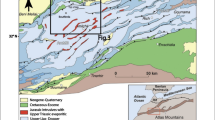Abstract
From the 1990s, geodiversity studies have been widely carried out in order to understand, describe and preserve the natural heritage of the abiotic environment. Geodiversity assessments have principally been conducted using geological (minerals, rocks and fossils), geomorphological (landforms and processes) and pedological variables. This concept has been widespread and consolidated in scientific circles, where early studies focused on methods that assessed the spatial variability of the geodiversity, with a particular focus on quantitative aspects. In this study, a geodiversity quantification methodology (Pereira et al. 2013) has been applied to the Xingu River basin (Amazônia, Brazil), which covers approximately 51 million hectares. This methodology is based on measuring and integrating abiotic elements, which are spatialised using thematic maps at scales varying between 1:250,000 and 1:1,000,000 and using a 1:25,000 systematic linkage grid. This methodology was adapted for the Amazonian environment by including parameters related to river channel patterns, as approximately 12.6 % of the area is a fluvial environment (channels and floodplains). After applying the methodology, geodiversity indices varying between 4 and 32 were obtained, and a geodiversity hot spot in the basin was identified in the region known as “Volta Grande do Xingu” (The Great Bend of the Xingu). The results of the study highlight the fragility of legal tools for environmental protection of the area, primarily those related to aspects of the physical environment. Although large portions of the basin are partially or fully protected (as indigenous lands and conservation units), the area with the greatest geodiversity is precisely the one which has fewer legal protection devices and is where the Belo Monte hydroelectric power plant is being built.










Similar content being viewed by others
References
Benito-Calvo A, Pérez-González A, Magri O, Meza P (2009) Assessing regional geodiversity: the Iberian Peninsula. Earth Surf Process Landf 34(10):1433–1445
Bruschi VM (2007) Desarrollo de una metodología para la caracterización, evaluación y gestión de los recursos de la geodiversidad. 2007. 355f. Tese (Doutorado em Ciências da Terra e Física da Matéria Condensada). Faculdade de Ciências da Universidade de Cantabria, Santander. (in Spanish)
Carcavilla Urqui L, López Martínez J, Durán Valsero J (2007) Patrimonio geológico y geodiversidad: investigación, conservación, gestión y relación con los espacios naturales protegidos. Cuadernos del Museo Geominero 7, IGME, Madrid (in Spanish)
CPRM - Geological Survey of Brazil (2004). State of Mato Grosso Mineral Resource Map. Scale 1:1,000,000. Available at: http://www.cprm.gov.br/. Accessed on Oct. 2011
CPRM-Geological Survey of Brazil (2008) GIS—Geology and Mineral Resources of the State of Pará. Digital archive in shapefile format. Accessed on Oct. 2011
Dixon G (1995) Geoconservation: an international review and strategy for Tasmania; a report to the Australian Heritage Commission, Occasional Paper No. 35, Parks & Wildlife Service, Tasmania.
ELETROBRAS (2009) Aproveitamentos Hidrelétricos da Bacia Hidrográfica do Rio Xingu: Relatório de Impacto Ambiental. São Paulo: Eletrobrás. Volume 1. 197 p (in Portuguese)
Gray M (2004) Geodiversity: valuing and conserving abiotic nature. Wiley, Chichester
Hjort J, Luoto M (2010) Geodiversity of high-latitude landscapes in northern Finland. Geomorphology 115:109–116
IBGE—Brazilian Institute of Geography and Statistics (2000) Cartographic base of the tematic mapping of Legal Amazonia (Shapefile format). Available at www.ibge.gov.br. Accessed on Sept. 2008
IBGE—Brazilian Institute of Geography and Statistics (2003). Pedological map of Legal Amazonia (Shapefile format). Available at www.ibge.gov.br. Accessed on Feb. 2007
Juliani C. et al. (2008) A gênese do vulcano–plutonismo Uatumã e das mineralizações de Au e de metais de base associadas nas regiões do Tapajós, Iriri E Xingu (PA). In: Simpósio de vulcanismo e ambientes associados, 4, 2008, Foz do Iguaçu, PR. Anais… Foz do Iguaçu (in Portuguese)
Kiernan K (1996) Conserving geodiversity and geoheritage: the conservation of glacial landforms; Report to the Australian Heritage Commission.
Kiernan K (1997) The conservation of landforms of coastal origin: conserving Tasmania’s geodiversity and geoheritage: forest practices unit, Hobart, Tasmania, 273 p
Kozlowski S (2004) Geodiversity. The concept and scope of geodiversity. Prz Geol 52(8/2):833–837
Pellitero R, González-Amuchastegui MJ, Ruiz-Flaño P, Serrano E (2011) Geodiversity and geomorphosite assessment applied to a natural protected area: the Ebro and Rudron Gorges Natural Park (Spain). Geoheritage 3(3):163–174
Pereira DI, Pereira P, Brilha J, Santos L (2013) Geodiversity assessment of Parana State (Brazil): an innovative approach. Environmental Management, v.52, p.541-522, 2013. Available at http://link.springer.com/article/10.1007%2Fs00267-013-0100-2. Accessed on Oct. 2013
Ruban D (2010) Quantification of geodiversity and its loss. Proc Geol Assoc 121:326–333
Schobbenhaus C. et al. (1984) Geologia do Brasil: texto explicativo do mapa geológico do Brasil e da área oceânica adjacente incluindo depósitos minerais, escala 1:250.000. Brasília: CNPM—Departamento Nacional de Produção Mineral (in Portuguese)
SEFAZ-MT—Secretaria da Fazenda do Estado do Mato Grosso (2009) Pesquisadores detalham realidade ambiental na bacia do Xingu. Available at http://www.sefaz.mt.gov.br/portal/index.php?action = noti&codg_Noticia = 10214. Accessed on May 2009 (in Portuguese)
Serrano E, Ruiz-Flaño P (2007) Geodiversity: a theoretical and applied concept. Geogr Helv 62(3):140–147
Sharples C (1993) A methodology for the identification of significant landforms and geological sites for geoconservation purposes; Report to Forestry Commission, Tasmania
Silva JP (2012) Morfologia fluvial como parâmetro de avaliação de geodiversidade -Aplicação na Bacia Hidrográfica do Rio Xingu. Tese do doutorado. Departamento de Geografia. Universidade de São Paulo, São Paulo
Silva JP, Pereira DI, Aguiar AM, Rodrigues C (2013) Geodiversity assessment of the Xingu drainage basin. J Maps 9:1–9
Strahler AN (1957) Quantitative analysis of watershed geomorphology. Trans Am Geophys Union 8(6):913–920
Zwoliñski Z (2010) The routine of landform geodiversity map design for the Polish Carpathian Mts. Landform Analysis 11:77–85
Author information
Authors and Affiliations
Corresponding author
Rights and permissions
About this article
Cite this article
de Paula Silva, J., Rodrigues, C. & Pereira, D.I. Mapping and Analysis of Geodiversity Indices in the Xingu River Basin, Amazonia, Brazil. Geoheritage 7, 337–350 (2015). https://doi.org/10.1007/s12371-014-0134-8
Received:
Accepted:
Published:
Issue Date:
DOI: https://doi.org/10.1007/s12371-014-0134-8




